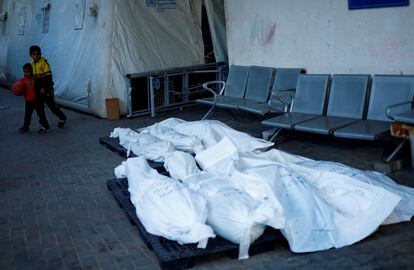Israel plans a post-war Gaza with Palestinian administration but under military control
The Minister of Defense rejects the return of Jewish settlers to the Strip, as demanded by radical members of the country’s government


Almost three months have passed since the outbreak of the bloodiest war in the Holy Land in half a century. Israel is already preparing for the day after the conflict, as it continues to systematically bombard the Gaza Strip and deploy troops to the Lebanese border. The Palestinian coastal enclave has been devastated, with more than 22,000 dead, but the Hamas militia, which triggered the conflict by killing 1,200 people in Israel, has not been eradicated. The only one of its leaders eliminated since Oct. 7, Saleh al-Arouri, was killed Tuesday in a drone operation in Beirut.
Faced with a war scenario that will last “as long as it takes,” predictably for “months,” despite some Israeli troops having begun to withdraw from the Gaza Strip, Israeli Defense Minister Yoav Gallant announced Thursday evening the beginning of a third phase of the war, which resembles an exit strategy. Once Israel’s military objectives have been achieved, Israeli officials foresee a post-war Gaza with limited Palestinian administration, based on “local committees” of mere management, but under the control of the Israeli army, which reserves full “operational freedom of action” to intervene inside the enclave.
Israel’s Security Cabinet met Thursday night to study the document presented hours earlier by the Defense Minister with the guidelines for the post-war future of Gaza. Although the civilian government of the territory would remain in the hands of the Palestinians, the minister’s report makes no reference to the Palestinian Authority (PA), which governs part of the West Bank under Israeli military occupation and which Prime Minister Benjamin Netanyahu had already said would not be in charge of Gaza after the current conflict. “Gaza residents are Palestinian, therefore Palestinian bodies will be in charge [of the administration], with the condition that there will be no hostile actions or threats against the State of Israel. (…) Hamas will not govern Gaza, [and] Israel will not govern Gaza’s civilians,” the document states.
Minister Gallant also envisions a Gaza without “an Israeli civilian presence” once the fighting is over. This plan threatens to cause divisions in Netanyahu’s right-wing coalition government, where four ultra-conservative ministers have already spoken out in favor of the return of Israeli settlers to Gaza, from where they were evacuated in 2005. The Minister of National Security, the radical Itamar Ben Gvir, called on Monday for the settlers to return to Gaza after the war and “encourage” the Palestinian population to emigrate. A view shared by the Minister of Finance, the religious ultranationalist Bezalel Smotrich.
Thursday’s meeting was interrupted by Netanyahu amid internal disputes, according to Hebrew media reports. Without the support of Ben Gvir and Smotrich’s deputies, the prime minister — the most conservative in Israel’s history — would be left with a minority in the Knesset (the country’s legislature).
For now, Israel has limited itself to announcing a fighting strategy focused on specific targets in the north of the Gaza Strip — a devastated and almost depopulated territory — and on the pursuit of Hamas political and military commanders in the south of the enclave, where the army suspects they are hiding, along with the 136 hostages captured in Israel almost three months ago. The southern part is now crowded with most of the more than 2 million Gazans, who were forced to flee south and who now face precarious conditions in the middle of winter. According to Israeli military forecasts, the thousands of displaced Gazans will not be able to return to their homes in the north until the hostages are released.
Amid growing international pressure to reduce the intensity of Israel’s attacks on Gaza, the defense minister announced a new phase of fighting “depending on the objectives achieved on the ground,” focused on the destruction of tunnels and command centers of the Izz ad-Din al-Qassam Brigades, the armed wing of Hamas. More than 163 Palestinians were killed between Thursday afternoon and midday Friday, according to the Gaza Health Ministry.
Deployment of international forces
The document outing the third phase of the conflict, which still has to be approved by the government, projects the deployment of an international force with troops from Western and moderate Arab countries for the reconstruction of the enclave, coordinated by the United States. Gallant anticipated that Egypt will have “a relevant role” in the future of Gaza, but declined to give details on the plans being negotiated with the authorities in Cairo, which include a reinforced technological border in the south of the Strip. Israel would also reserve the right to inspect the entry of goods at customs.
Israel continues to hope that Hamas will not rule Gaza after the war, where it seized power by force in 2007, having defeated the Fatah party of Palestinian Authority President Mahmoud Abbas at the polls the previous year. Even if the Islamic resistance movement loses control of the territory, Hamas-affiliated civil servants and public employees are expected to remain in their posts to ensure the provision of essential services.
The announcement of Israel’s post-war vision for Gaza comes on the eve of U.S. Secretary of State Antony Blinken’s Middle East tour, his fifth since Oct. 7. He is scheduled to visit Israel on Monday to get a first-hand look at plans for “the day after” the conflict — a date that Netanyahu seems neither politically nor personally interested in seeing materialize in the near future, primarily because he is hanging on to power by a thread.
“The war has to this day achieved none of its objectives. There have been operational achievements on the ground, but there is no exit strategy,” warned Israeli analyst Nahum Barnea in the pages of the daily Yedioth Ahronoth on Friday. “The army expects the same rules of the game to apply as in the northern West Bank, where it enters cities and villages at will and has partial cooperation from the Palestinian civil administration,” argues this veteran columnist, “but Gaza is not Jenin,” he writes. “And with the collapse of the Hamas administration it will become a black hole, the same as the aerial photographs of the Strip show.”
Sign up for our weekly newsletter to get more English-language news coverage from EL PAÍS USA Edition
Tu suscripción se está usando en otro dispositivo
¿Quieres añadir otro usuario a tu suscripción?
Si continúas leyendo en este dispositivo, no se podrá leer en el otro.
FlechaTu suscripción se está usando en otro dispositivo y solo puedes acceder a EL PAÍS desde un dispositivo a la vez.
Si quieres compartir tu cuenta, cambia tu suscripción a la modalidad Premium, así podrás añadir otro usuario. Cada uno accederá con su propia cuenta de email, lo que os permitirá personalizar vuestra experiencia en EL PAÍS.
¿Tienes una suscripción de empresa? Accede aquí para contratar más cuentas.
En el caso de no saber quién está usando tu cuenta, te recomendamos cambiar tu contraseña aquí.
Si decides continuar compartiendo tu cuenta, este mensaje se mostrará en tu dispositivo y en el de la otra persona que está usando tu cuenta de forma indefinida, afectando a tu experiencia de lectura. Puedes consultar aquí los términos y condiciones de la suscripción digital.
More information
Archived In
Últimas noticias
Most viewed
- Reinhard Genzel, Nobel laureate in physics: ‘One-minute videos will never give you the truth’
- Oona Chaplin: ‘I told James Cameron that I was living in a treehouse and starting a permaculture project with a friend’
- Pablo Escobar’s hippos: A serious environmental problem, 40 years on
- Charles Dubouloz, mountaineering star, retires at 36 with a farewell tour inspired by Walter Bonatti
- Why we lost the habit of sleeping in two segments and how that changed our sense of time










































